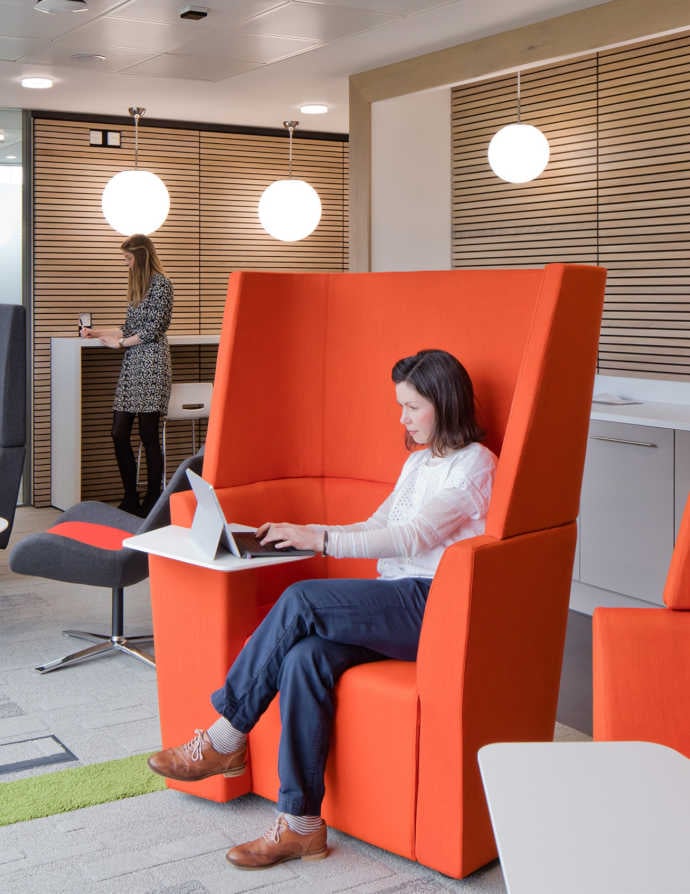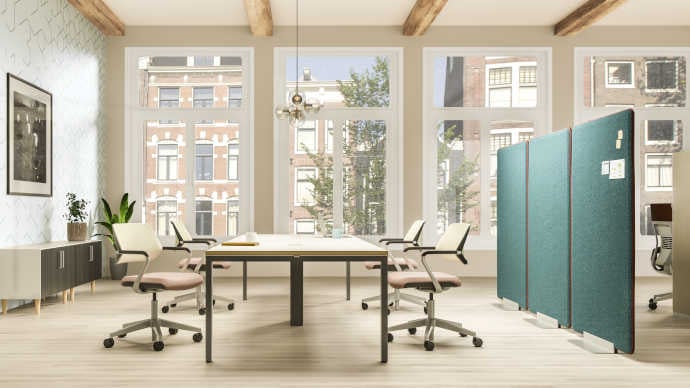It’s widely recognised that noise is the number one distraction in the workplace. While open-plan offices have been designed to foster collaboration, the lack of walls and barriers in these spaces have exposed workers to an elevated level of noise, leaving them distracted and stressed.
The open-plan workspace has many benefits, including knowledge sharing, innovation and social interaction. But organisations need to provide working environments that support these practices whilst simultaneously protecting workers against disruptive noise.
According to the Steelcase report Acoustics, Work and the Physical Environment, addressing acoustical comfort in the office is key to a productive workspace.
The noise problem
The sound around us has a huge impact on our health and wellbeing. As The Sound Agency explains:
“Sound affects our bodies, from our hormone secretions to our heart rates. It affects our feelings, moods and emotions. It affects our productivity and ability to think. It affects our behaviour, from how fast we move to which brands and products we like and buy.”
One study revealed that people try to combat noise distractions by working faster, but that this comes at a price, with people experiencing more stress and frustration. The frustrations are also felt by the business, given brief interruptions can double a worker’s error rate.
The cost of distraction
Noise pollution can lead to increased stress levels and dissatisfaction not just with the work environment but also with the job itself.
In one study, 99% of workers reported that their concentration was impaired by office noise, especially telephones left ringing at vacant desks and people talking in the background.
Another study reveals nearly 50% of people with a complete open-office floor plan and nearly 60% of people in cubicles with low walls are dissatisfied with their sound privacy.
Steelcase research shows people who are highly dissatisfied with their work environment are also highly disengaged at work - and the cost of this disengagement in the UK is estimated to be between £52-70 billion.
Workplace trends exacerbate the problem
Design trends have seen industrial spaces with high ceilings, large windows and open, airy atmospheres become more popular - and these spaces carry noise. The rising costs of property also means companies are opting to lease office spaces for shorter periods, where they have no control over acoustic elements like ceiling insulation, wall thickness and window size.
On top of this, the trend towards flexible workspaces has meant fewer fixed furniture and soundproof elements, which means sound waves are free to travel the space, impacting acoustic comfort.
How sound travels in the workplace
Before we look at how to address acoustic comfort, let’s take a quick look at how sound travels in the workplace.
When a conversation takes place at one end of the office, it produces sound waves that spread out towards walls, ceilings and floors, as well as other items in the room. If all the surfaces in the space are hard and reflective, the sound waves reflect and reverberate, with the sound taking longer to disperse.
Choosing office furniture to reduce noise
Organisations may have little control over the architecture of the workspace they’re in, but they can improve acoustic comfort by choosing office furniture that reduces noise.
Office furniture such as cabinets, lockers, desk screens and freestanding screens, can all be finished with different materials to help avoid excessive reverb and deaden sound. Storage units with acoustically absorbing material in the front and back can help lower noise levels and provide boundaries between teams.
Wall panels and suspended ceiling panels can also be added to spaces to absorb sound and reduce reverberation. As well as creating a more ambient workspace, they can also be a great visual feature.


Design for acoustical privacy
Another way to support the wellbeing and productivity of staff is by providing spaces designed for optimal acoustical privacy, where employees can go to do focused work or relax and recharge.
Chairs with high backs and fabric upholstery, as well as pods and booths, can provide quiet havens for employees within an otherwise noisy and distracting office. They can easily be incorporated into open-plan environments, providing a “room within a room” for workers to concentrate or rejuvenate free from distractions.


Office furniture with acoustic qualities can be placed almost anywhere within the office environment. Armchairs and privacy sofas can be positioned alone for private work or linked together to create collaborative work. Technology can be built in to support video conferencing or presentations.


Acoustic screens
Acoustic screens are a simple and cost effective way to separate parts of the office into group spaces and semi-private workspaces.

Peace in a Pod?
Enclosed pods offer an even greater level of acoustical privacy. Officebricks Acoustic Pods, for example, provide two-way sound insulation. Sound outside of the pod remains outside and conversations inside the pod remain private. Installation requires no drilling, bonding or screwing, meaning they can be easily relocated to different spaces within the office and move with you if you move premises.
These private enclaves support a range of tasks, including focused work, relaxation, brainstorming and team meetings.

“I think people are discovering that they want a great user experience when they’re using a pod. They want acoustics at the right level. They don’t want to feel like they’re in a submarine where they can’t hear anything or have any sense of the outside. But, at the same time, they don’t want to hear their neighbors or have their neighbors hear them.” Niki Watt, Steelcase

Summary
While the open-plan office has brought people together, it has amplified the importance of designing for acoustic comfort.
Choosing office furniture that supports acoustic comfort and providing spaces to maximise acoustical privacy are key for modern businesses. Exactly what this workspace looks like will be unique to each individual company, based on workers’ needs and how well the architecture of the building supports noise reduction.
Ultimately, if you want to attract and retain top talent you need to be offering a workspace designed to support employee wellbeing. With noise being one of the biggest irritations for workers, addressing acoustic comfort is key.









